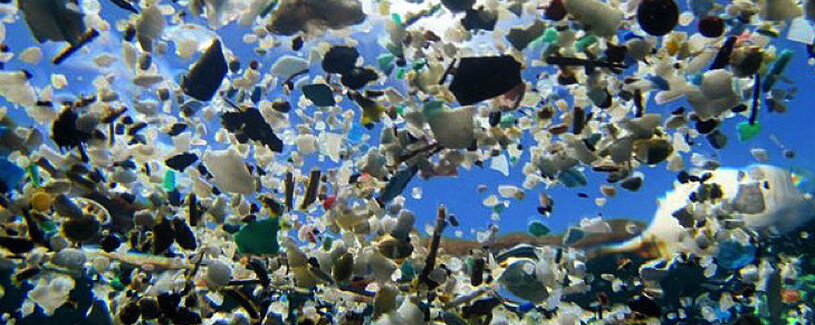The Plastic Problem
Eight million tons of plastic waste enter our oceans every year. That’s a big problem. But how did we get to this point?

About 8 million tons of plastic waste enters our oceans every year. That’s roughly 500 pounds per second. The result is predictable: plastics are in everything. They are in Cuvier's beaked whales off the coast of Norway and sperm whales beached in Germany; they are in 90 percent of seabirds; they are in table salt, and also in most tap water samples across the world. More than 80 percent of these marine plastics come from land-based sources.
As a result, plastic has become a subject of increased scrutiny, particularly regarding its potential effects on environmental and human health. At this point, the effects on human health remain largely unknown. “There are more questions than answers,” says Richard Thompson, a professor of marine science and engineering at England’s Plymouth University. Marine plastics act as a sink for other toxic chemicals in the ocean. (This very property of microplastics can also be used to benefit the environment: removing microplastics that have sopped up toxics will remove these other chemicals.) One can safely assume that ingestion of marine plastic debris, whether by people or other animals, therefore means taking a concentrated dose of toxic chemicals in addition to the plastic itself. Externally, and more visibly, marine species frequently suffer from entanglement in plastic debris like discarded fishing nets or choking through ingestion.
Environmental and health effects aside, plastic loss is a basic economic problem. The World Economic Forum estimates that the continuous loss of plastics to the oceans, a material that can be recovered, implies an annual loss of $80-$120 billion worth of material.
That said, there are two reasons this problem is not as visible as one might expect—why you likely did not spot plastics when you last took a walk along the beach. First, more than 50 percent of the plastics in the ocean sink. Imagine the plastic like pepper in your soup, scattered across the ocean column. Second, this pollution is also in the form of “microplastics,” which are less than 5mm (roughly one-fifth of an inch) in diameter. These microplastics are increasingly pervasive—in your face wash, in many whitening toothpastes, in soap and detergents, in tires, in your sportswear, and even in paints. These microplastics get into the drains by one way or the other and it is unclear how many wastewater treatment plants can actually filter them out. Some studies suggest that up to 90 percent of microplastics can be filtered in certain types of wastewater treatment plants. However, if the wastewater treatment plant is unable to capture microplastics they are eventually washed out to the ocean.
How we got to this stage—the WEF describes plastics as “the ubiquitous workhorse material of the modern economy”—is, in some sense, straightforward: plastics are cheap, easy to manufacture, and amazingly versatile—used for toothbrushes, computers, packaging consumer goods, and even for Boeing 787s, where plastic was a light-weighting breakthrough. Plastics are impervious to water and far lighter than wood, stone, metal or glass. They can help preserve food shelf-life and have gone a long way in helping to solve hunger problems around the world. They do not corrode like the metal, nor do they break like the glass.
Given this versatility, plastic adoption has been pervasive. The shoe industry uses lightweight polyurethane and thermoplastic rubber soles; as you walk, this material sloughs off and washes into waterways. The textile industry has moved from 100 percent cotton to mixed fibers, or even 100 percent polyester fiber in most sportswear. When laundered, these materials shed plastics. Even tires, as they wear, wash microplastics into the drains because they are essentially synthetic rubber made with plastics.
In short, because adoption has been pervasive, the problem is now pervasive.
But solving the problem presents deep and multifaceted challenges. Consider the soft drink industry, one of the most visible users of PET. The introduction of PET plastic bottles in the 1970s made for larger, stronger, and much lighter containers that were essentially sold as one-time use. This helped save on raw material (by weight) and shipping costs; it also saved the hassle of glass buybacks. Soft drink manufacturers passed many of these savings on to consumers. The low prices today reflect both razor-thin operating margins and a conundrum: in efforts to reduce the use of plastic bottles, those who use them will require collaboration from all societal stakeholders and financial contributions in order to provide effective solutions.
Suppliers in many industries have become dependent on the use of plastic; consumers have come to expect the myriad conveniences offered by plastic, which is genuinely something of a wonder-material. In fact, stand-up comedian, George Carlin has performed a satirical routine noting that plastics might be the answer to that age-old philosophical question, “Why are we here?” If that’s the case, then this mundane raison d’etre inherently gives rise to a second, less mundane one: What efforts are being taken to address this problem? Part 2 of this series tackles that question.